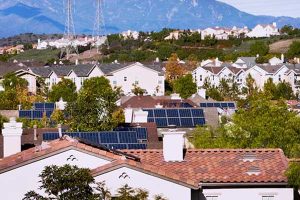Utah-based Lumio, a residential solar panel provider, has filed for Chapter 11 bankruptcy in Delaware, listing its assets and liabilities in the range of $100 million to $500 million.
The filing comes with a plan to sell the business to its primary lender, White Oak Global Advisors LLC, through a $100 million credit bid, allowing White Oak to use the debt owed by Lumio toward the acquisition.
Solar Industry Struggles Amid Economic Pressures

Rooftop view of houses with solar panels in a residential locality in California, US. (Credit: theguardian)
Lumio’s bankruptcy reflects growing challenges in the U.S. solar industry, which has been hit by a combination of subsidy cuts in California and rising interest rates.
These factors have made solar installations less affordable for homeowners, straining companies like Lumio.
Just weeks ago, another industry player, SunPower, also sought bankruptcy protection, signaling broader financial difficulties for the sector.
White Oak’s Commitment and Employee Ownership Plan
Despite the bankruptcy filing, Lumio plans to continue operations uninterrupted.
White Oak has committed to providing $8 million in financing to keep the business running during the Chapter 11 process.
Furthermore, if White Oak’s bid is successful, the firm intends to offer significant equity ownership to Lumio employees, aiming to stabilize the company post-bankruptcy.
Outlook on the Solar Industry
While Lumio’s case underscores the solar sector’s current financial strain, it also highlights the importance of long-term strategic investment.
The industry, despite its present challenges, remains key to the U.S.’s renewable energy future.
However, companies will need to navigate an increasingly volatile economic landscape to thrive.










Comments